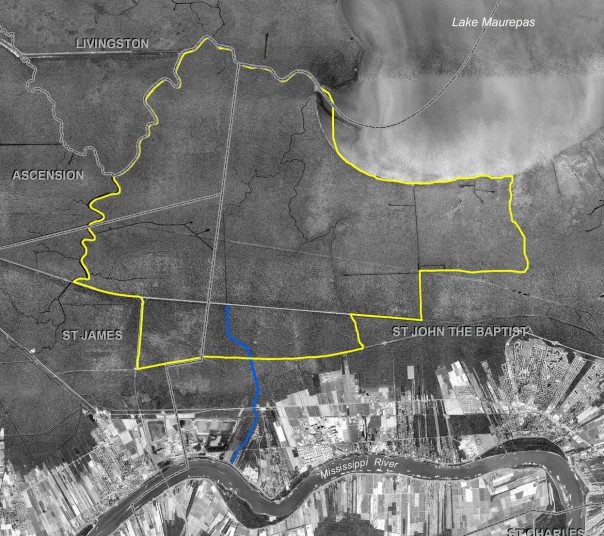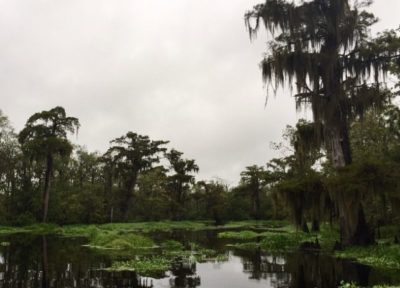Louisiana’s coastal restoration agency has gotten about $14 million to engineer a system to reconnect the Mississippi River to the Maurepas Swamp, which has been cut off from its rejuvenating floodwaters for about 80 years.
The money comes from the Restore Council, established by Congress to allocate fines from the BP oil spill.
The swamp, which is mostly forested wetlands, has been dying for decades due to logging and the levees built along the river to prevent flooding. Canals dug to remove cypress trees have allowed saltwater to penetrate into the swamp, killing trees.
“Humans have done a really good job of messing up how the water flows to the swamp,” said Melissa Baustian, a coastal ecologist for The Water Institute of the Gulf.
The grant will pay for the design and engineering of a system to carry freshwater and sediment from the river five miles north to the swamp.
When finished, it will be the first river diversion in Louisiana designed to restore swamp forest, according to researchers with the state Coastal Protection and Restoration Authority. Most diversions planned for Louisiana are meant to rebuild areas of marsh that have become open water.
The Maurepas Swamp diversion is outlined in the Coastal Master Plan, an ambitious, 50-year blueprint designed to protect and restore Louisiana’s crumbling coast.
The coastal authority describes it as a $50 billion plan. Researchers with the Tulane Institute on Water Resources Law & Policy estimate it will cost closer to $100 billion.
The Master Plan pegs the total cost of the Maurepas Swamp diversion, located south of Lake Maurepas in St. John the Baptist Parish, at $185 million.
$185 millionEstimated cost to build the diversion70Square miles to be restored, about a third of the swamp
Scientists say the diversion is important because the swamp is the second largest coastal forest remaining in Louisiana. Experts estimate that 50 to 75 percent of bottomland hardwood forest has been lost since settlers first arrived.
The 220 square-mile Maurepas Swamp includes bald cypress and tupelo trees.
Like other swamps in coastal Louisiana, its health is in peril. Levees built along the Mississippi after the Great Flood of 1927 have prevented towns from flooding, but they also have starved some areas of the freshwater that soaked nearby areas when the river overtopped its banks.
Over the years, saltwater has flowed into the swamp from canals and Lake Pontchartrain during severe storms and droughts. The saltwater prevents certain trees from retaining nutrients.
River levees have also affected the swamp’s health by cutting off the influx of sediments that offset the natural sinking of the land in this area.
The Maurepas Swamp still gets some freshwater from the Comite and Amite rivers, which drain into Lake Maurepas, Baustian said.
“Humans have done a really good job of messing up how the water flows to the swamp.”—Melissa Baustian, The Water Institute of the Gulf
The diversion project will help scientists plan three other diversions for swamps in the Master Plan, said Bren Haase, the chief of the state Coastal Protection and Restoration Authority’s research division.
The other projects aim to sustain the Central Wetlands near Violet in St. Bernard Parish, divert fresh water into the West Maurepas Swamp near Burnside in Ascension Parish, and increase the flow of freshwater in the Manchac Land Bridge between lakes Pontchartrain and Maurepas.
“We’re trying to figure out the best way to optimize this thing,” Haase said about the Maurepas project.
If the diversion is built as planned, it’s expected to restore or enhance about 70 square miles of forested wetlands, about a third of the swamp.
The water would flow at a maximum rate of 2,000 cubic feet per second through a gated structure in the river near Garyville, near the western edge of St. John the Baptist Parish. A channel would carry it into the swamp.

This diversion will carry much less water than others in the Master Plan, said Brad Miller, project manager for the Maurepas Swamp diversion. But that’s by design. Smaller amounts of water may better serve the wildlife dependent on the swamp, he said.
“Think of it as watering your garden,” he said. “When watering your garden, it’s not always the best idea to put the sprinkler on all the time.”
Miller said scientists are still trying to determine when the diversion should be open, including whether it should be seasonal.
Michael Ellis, executive director of the coastal authority, said the engineering grant represents a “significant milestone” in the restoration of Maurepas Swamp’s ecosystem.
It’s “urgently needed,” he said, to prevent further land loss and rising salinity levels throughout the entire Pontchartrain Basin.

Ultimately, scientists hope to preserve mature bald cypress and other woody vegetation, which in turn is expected to help wading birds, migratory birds, bald eagles, alligators and other wildlife.
The diversion is designed to benefit humans, too. Researchers say it will help preserve a significant land buffer against storm surge that can build up in lakes Pontchartrain and Maurepas.
The swamp helps protect communities in St. John the Baptist, Ascension, Livingston, and St. James parishes. It also protects chemical plants and oil and gas refineries along the river.
Researchers have been studying how to save the Maurepas Swamp from starvation since at least the 1990s.
One of them is is Gary Shaffer, a professor of biological sciences at Southeastern Louisiana University. In 2001, he wrote that the Maurepas Swamp had entered “a severe state of deterioration.”
With more saltwater penetrating, “most of the Maurepas Swamp appears to be in transition to marsh and open water,” Schaffer wrote in the Journal of Coastal Research, as shared in Science Daily.
He advocated then for a diversion to save what was left of the coastal forest swamp. Now, the Maurepas Swamp diversion is one of 11 outlined in the Master Plan to save Louisiana’s coast.
“Swamps take a long time to die and a long time to restore.”—Gary Shaffer, Southeastern Louisiana University
The Restore Council has selected seven projects in Louisiana. In August, the coastal authority announced it had received $19.5 million to expand a system to collect data on the effect of coastal restoration projects.
The Maurepas project is supposed to be finished in the next decade. The true timeline for it and other projects, however, is uncertain because the state doesn’t have enough money to fund all the projects in the Master Plan.
Scientists still have time — at least for this project, Miller said.
“The swamp has been dying for a long time,” he said. “Swamps take a long time to die and a long time to restore.”

